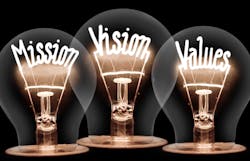Building Authentic Culture
By Jeff Plant
Everybody talks about company culture these days, but very few people in the industry understand what it really means. Even fewer people know how to build one.
An effective, authentic culture means each team member is continuously living out the mission, vision and values of the company. Whether it’s answering the phone or talking to clients, every single task should be aligned with the company’s goals. You and your team members should constantly be asking three questions:
· Does this action help us accomplish our mission?
· Does it help us reach our vision?
· Does it support our values?
When you and your employees are making decisions based on fulfilling the company’s mission, vision and values, it creates a highly productive environment, where technicians, office staff, management and leadership are all working toward the same goals.
Culture begins with trust
The key element for building that environment and developing a genuine culture that lives up to your company’s values is trust. Teams have to trust the leadership of the company, and you need visionary leadership that can cast the right vision and get team members to buy into it.
Ultimately, trust and loyalty start with leadership. The trust exchange that’s needed to build authentic culture starts at the top. Expect the best from your team and show them they can expect the same from you, and you’ve taken the first big step in leading your company to an authentic, productive culture.
A common question I’ve heard in training sessions is, “What if I spend time and money to train my techs and then they leave?” My response is always the same: “What if you don’t train them and they stay?”
I’ve also heard contractors say there’s no loyalty in the industry. “My techs would jump ship for the next company that offers them another dollar an hour,” they say. But 99% of the time it’s because the employer doesn’t value the employee.
The costs of high turnover and employee apathy, which results in negative impacts for customers, will be more detrimental in the long term versus investing in culture now through developing your team. When employees have the tools and knowledge to contribute, they begin to feel they’re part of something bigger that goes beyond a wage.
How do you do this? You must get them to buy into your vision and include them in company decisions. If there’s an issue that needs a solution, ask all the team members involved to come back with two or three ideas to fix the situation. If you ask for one idea and don’t use it, you risk discouraging some employees. If you can include elements from multiple ideas, they’ll feel like part of the solution and be empowered to take action.
Lead by example
A critical part of building culture through effective leadership is personal accountability. The leaders of a company must meet the same high standards of character and performance they expect their employees to live up to.
· If you make a mistake, own it. Acknowledge your misstep, rally your team, and move forward.
· Do what you say. Follow through with decisions. If you constantly implement big changes and then let things slide back to normal, your team will notice. If you promise a bonus or added benefit for achieving benchmarks, deliver.
· Back your team. Don’t automatically let techs or dispatchers take the heat from dissatisfied customers. Review the situation and make a fair assessment before assigning blame.
· Act decisively. Don’t let difficult decisions linger. Don’t tolerate behavior that’s detrimental to the company or individuals.
· Stick to the vision. Sometimes a leader’s instinct in a difficult situation is to change the vision — to adapt their long-term goals for the company based on temporary circumstances. In most cases, the better solution is to change your path toward the vision. Did you hit a bump in the road? Get your team together and figure out why you hit that bump and how to get past it. Then take steps to make sure you don’t hit any more bumps like that.
Several years ago, I called one of my branch managers in Southwest Florida for an update. “Everything’s good,” he said. I called again a few weeks later and he said the same thing. When I called him the third time, he said, “Everything’s good, man.”
“Let me tell you something,” I said. “If I call you one more time and you say, ‘Everything’s good,’ I’m going to fire you. I’ve been in business long enough to know that everything’s not always good and now you’ve got me worried, so I’ll be down there in a couple of days to check.”
And guess what? Everything wasn’t good.
Every business faces challenges. How you respond during tough periods is the ultimate opportunity to lead a team to a trust relationship and build a better culture. When the people at the top of a company fall short and fail to lead, employees notice. When they see managers and leadership embodying the company’s values, they see that too. When they see leaders who know where they’re going and how to get there, a team has a reason to stick together and work toward a long-range vision.
Jeff Plant, a head coach at Business Development Resources (BDR), has 26 years of experience in the contracting trades, including 20 in HVAC. With roles in installation, service and building automation for the residential, commercial and industrial markets, Jeff rose from an entry-level position to chief operating officer for a $40 million business. Jeff’s success reflects his professional drive, organizational skills and commitment to strengthening his business education and HVACR technical skills.
